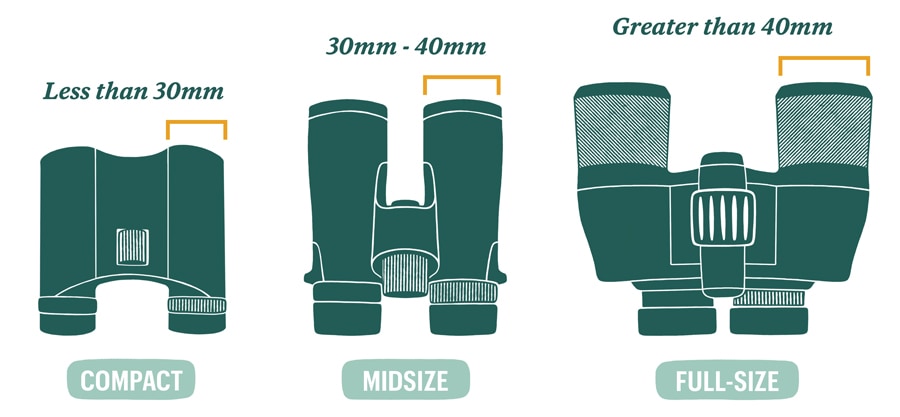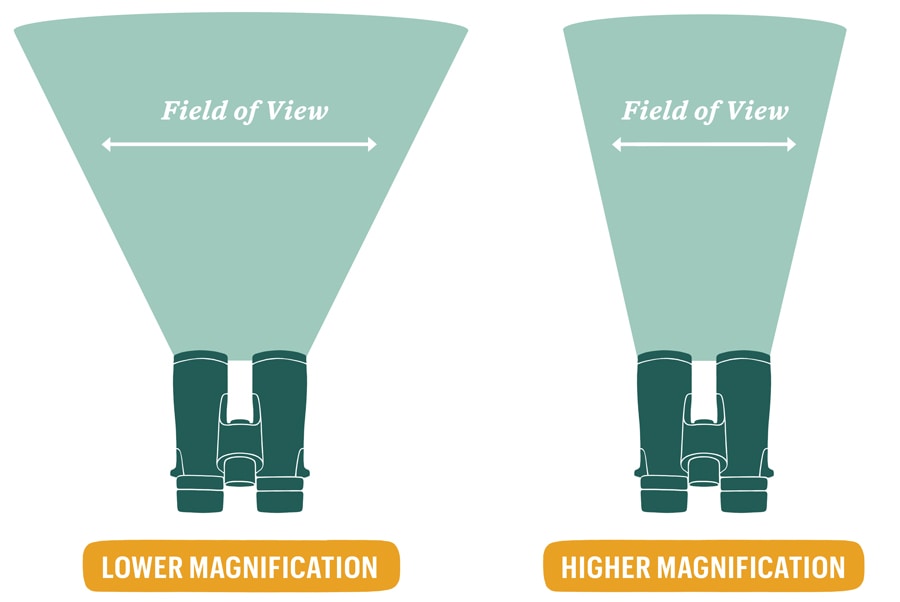For simplicity, binoculars are broken down into compact, midsize and full-size categories, based on the size of their objective lenses (the second number in model names). Note, though, that variations in optics, design and construction can still mean that models with the same size objective lenses will differ in size and weight.

Compact Binoculars: Objective lens size is less than 30mm (8x25, 10x28, etc.)
Midsize: Objective lens size is from 30mm to 40mm (10x30, 8x32, etc.)
Full-size: Objective lens size is greater than 40mm (8x42, 10x50, etc.)
If the binoculars are going inside your pack, then lightweight compact models make sense. Midsize models can give you brighter images and be more comfortable to hold for long periods. That might change with larger full-size binoculars, which some people find too heavy to hold for extended periods of time.
Most of the time, you’ll be choosing between a magnification of 8 or 10, though you can also find models with lower or higher magnifications.
8-power binoculars: A wider field of view
10-power binoculars: A closer, more detailed look
An 8x25, 8x32 and 8x42 pair of binoculars all provide the same magnification: An object will appear 8 times closer than it would to your unassisted eye.
A note about zoom binoculars: Though this sounds like the ultimate solution, there are tradeoffs in image quality. If you’re considering a pair of zoom binoculars, then compare them with a few single-magnification models before you make a final choice.
While it might seem that more magnification is always better, that’s not always the case. Because magnification also amplifies the movement of your hands, binoculars with magnification powers greater than 10 make steady viewing difficult, so they would be a poor choice if you will be on a boat or other moving platform.
Magnification power also has a direct effect on your field of view (lower magnification expands it; higher magnification narrows it).

Having a narrower field of view can make it harder to locate small and/or moving objects (like birds) when you scan far away. That smaller field of view also lets in less light, so images will be slightly darker.
Because other factors, like eyepiece design, also play a role, the “field of view” spec is the one to check in order to get the true picture here. This spec states the width of the area you can view at a glance, 1,000 yards from where you stand.
Be aware that binoculars with otherwise identical specs can have dramatically different fields of view (as much as 90 feet wider at 1,000 yards). So, always check that spec whenever you’re doing final comparisons.
The diameter of the objective lenses plays a key role in how much light your binoculars can gather. For two pairs of binoculars that otherwise have exactly the same specifications, the pair with larger objective lenses will capture more light, providing a brighter image. (Binoculars with higher quality optics will also have brighter images.)
Simply put, a higher number means brighter images. A higher number indicates better viewing in low-light situations, and it will be easier to maintain a full image of an object if your hands move or shake.
Exit pupil size is calculated by dividing the diameter of the objective lenses by the magnification number. For 8x42 binoculars, 42 divided by 8 equals an exit pupil diameter of 5.25mm. It indicates the size of the shaft of light that reaches your eyes, whose pupils vary from about 2mm in bright light to 7mm in total darkness.
For low-light situations, an exit pupil of 5mm or more is good: At dawn, dusk or with dense tree cover, having a high exit pupil number can make viewing easier.
For bright daylight viewing, exit pupil size is less important because almost all binoculars offer exit pupils that exceed 2mm.
Eye relief is the distance between an eyepiece and your eye while the whole field of view is visible. This is a key spec if you wear glasses.
If you wear glasses, look for eye relief of 11mm or more.
Most binoculars have adjustable eyepieces that allow you to set them to their maximum eye relief value (the stated spec). That is usually done by rolling down rubber eyecups or by twisting a collar to shorten the eyepieces.
Contact: Daniel
Phone: 13383770088
E-mail: daniel@kingopt.com
Whatsapp:
Add: No.4 Industrial Park, Nanyang ,Henan,China